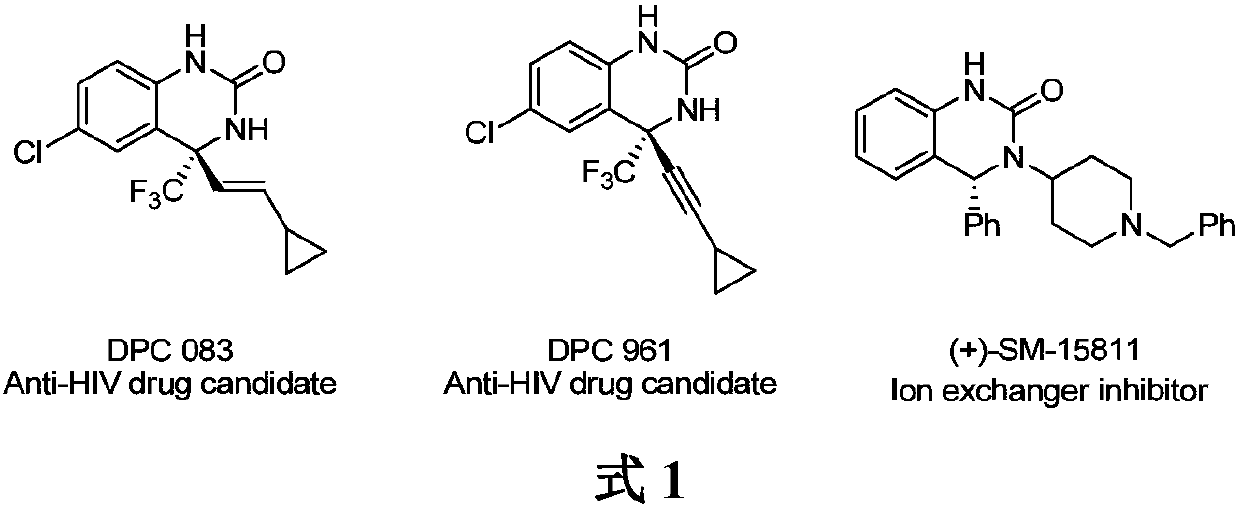Method for synthesizing chiral 3,4-dihydroquinazolinone through asymmetric hydrogenation of quinazolinone compound under catalysis of iridium
A dihydroquinazolinone, asymmetric technology, applied in organic chemistry methods, organic chemistry and other directions, can solve problems such as limited substrate scope, and achieve the effects of reducing aromaticity, convenient preparation and good reaction selectivity
- Summary
- Abstract
- Description
- Claims
- Application Information
AI Technical Summary
Problems solved by technology
Method used
Image
Examples
Embodiment 1-13
[0035] Optimization of the Reaction Conditions for the Hydrogenation of 4-Substituted Quinazolinones
[0036] Put 1,5-cyclooctadiene iridium chloride dimer (0.5mol%-5mol% of substrate consumption) and chiral bisphosphine ligand (1.1mol%-11mol% of substrate consumption) in the reaction bottle ), add an organic solvent (1.0-4.0mL) after nitrogen replacement, and stir at room temperature for 10 minutes; 5 mol%-30mol% of the amount used), moved to the reaction kettle, introduced hydrogen (400psi-800psi), and reacted for 24 hours at 25-80 degrees Celsius; released hydrogen, and directly separated by column chromatography after removing the solvent to obtain For the target product, 13 different examples were obtained by changing the types of organic solvents, additives, and chiral bisphosphine ligands during the reaction, and the types of changes are shown in Table 1. The reaction formula and ligand structure are as follows:
[0037]
[0038] Note: In the formula [Ir(COD)Cl] 2...
Embodiment 14-28
[0043] Iridium-Catalyzed Asymmetric Hydrogenation of 4-Substituted Quinazolinones
[0044] Drop into 1,5-cyclooctadiene iridium chloride dimer (1.0mol% of substrate consumption) and (R)-SegPhos (2.2mol% of substrate consumption) in reaction bottle, add tetrahydrofuran (THF) after nitrogen replacement ( 1.0 mL), stirred at room temperature for 10 minutes; then this solution was transferred to an ampoule containing substrate 1 (0.3 mmol) and bromochlorohydantoin (10 mol%) with tetrahydrofuran (2.0 mL), and moved to the reaction kettle , pass into hydrogen (600psi), react 24 hours under 25 degrees centigrade; Release hydrogen, remove the direct column chromatography separation after solvent to obtain pure product, change the kind of substrate in the reaction process, obtain 15 different embodiments, change Please refer to Table 2 for details. The reaction formula is as follows:
[0045]
[0046] Note: In the formula [Ir(COD)Cl] 2 It is 1,5-cyclooctadiene iridium chloride di...
PUM
 Login to View More
Login to View More Abstract
Description
Claims
Application Information
 Login to View More
Login to View More - R&D
- Intellectual Property
- Life Sciences
- Materials
- Tech Scout
- Unparalleled Data Quality
- Higher Quality Content
- 60% Fewer Hallucinations
Browse by: Latest US Patents, China's latest patents, Technical Efficacy Thesaurus, Application Domain, Technology Topic, Popular Technical Reports.
© 2025 PatSnap. All rights reserved.Legal|Privacy policy|Modern Slavery Act Transparency Statement|Sitemap|About US| Contact US: help@patsnap.com



